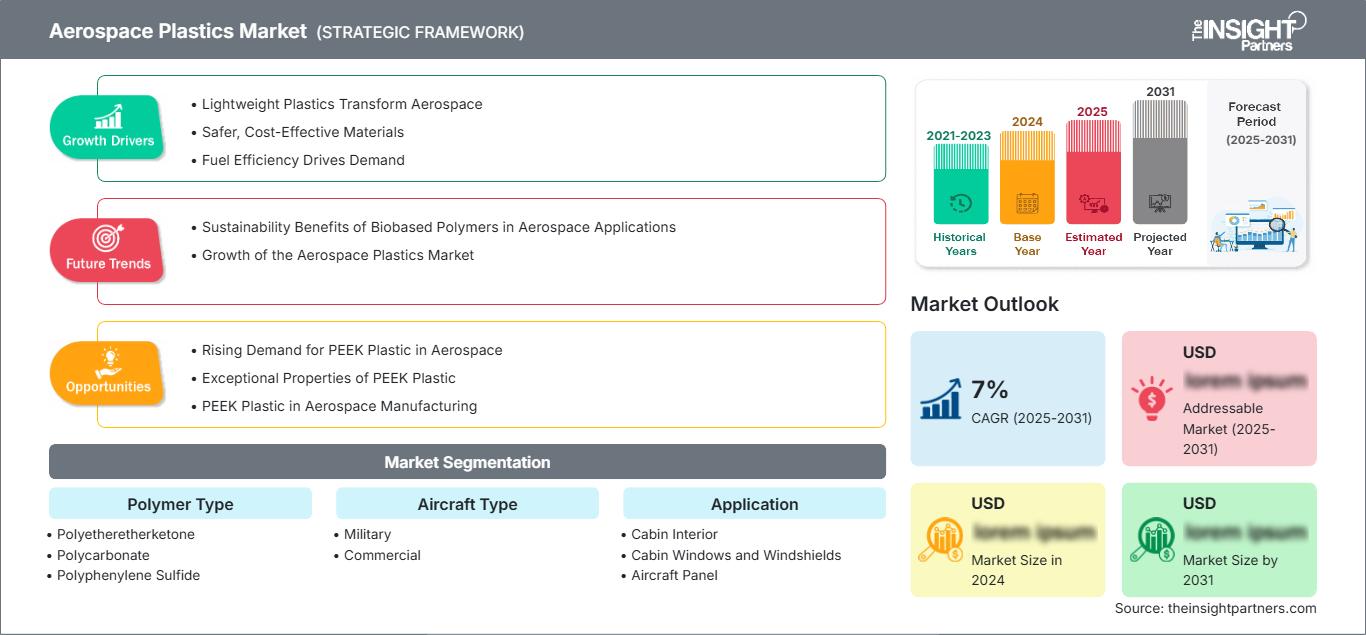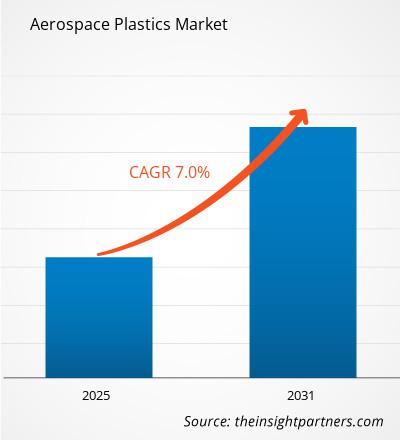Aerospace Plastics Market Growth, Trends, and Forecast by 2031
Historic Data: 2021-2023 | Base Year: 2024 | Forecast Period: 2025-2031Coverage: Aerospace Plastics Market covers analysis By Polymer Type (PEEK, PMMA, PC, PPS, ABS, Others); Application (Aerostructure, Components, Equipment, Systems and Support, Cabin Interiors, Propulsion Systems Satellites, Construction and Insulation Components, Others); End User Industry (Commercial and Freighter Aircrafts, Military Aircraft, Rotary Aircrafts, General Aviation, Others) , and Geography (North America, Europe, Asia Pacific, and South and Central America)
- Report Date : Mar 2026
- Report Code : TIPRE00005464
- Category : Chemicals and Materials
- Status : Upcoming
- Available Report Formats :


- No. of Pages : 150
The Aerospace Plastics Market is expected to register a CAGR of 7% from 2025 to 2031, with a market size expanding from US$ XX million in 2024 to US$ XX Million by 2031.
The aerospace plastics market report is segmented by polymer type (polyetheretherketone, polycarbonate, polyphenylene sulfide, polyetherimide, polyethersulfone, polymethyl methacrylate, and others). The report further presents an analysis based on the aircraft type (military, commercial, and others). The report is segmented based on the application (cabin interior, cabin windows and windshields, aircraft panel, and others). The global analysis is further broken down at the regional level and major countries. The market size and forecast at global, regional, and country levels for all the key market segments are covered under the scope. The report offers the value in USD for the above analysis, segments, regions, and countries.
Purpose of the Report
The report Aerospace Plastics Market by The Insight Partners aims to describe the present landscape and future growth, top driving factors, challenges, and opportunities. This will provide insights to various business stakeholders, such as:
- Technology Providers/Manufacturers: To understand the evolving market dynamics and know the potential growth opportunities, enabling them to make informed strategic decisions.
- Investors: To conduct a comprehensive trend analysis regarding the market growth rate, market financial projections, and opportunities that exist across the value chain.
- Regulatory bodies: To regulate policies and police activities in the market with the aim of minimizing abuse, preserving investor trust and confidence, and upholding the integrity and stability of the market.
Aerospace Plastics Market Segmentation
Polymer Type
- Polyetheretherketone
- Polycarbonate
- Polyphenylene Sulfide
- Polyetherimide
- Polyethersulfone
- Polymethyl methacrylate
Aircraft Type
- Military
- Commercial
Application
- Cabin Interior
- Cabin Windows and Windshields
- Aircraft Panel
Geography
- North America
- Europe
- Asia-Pacific
- South and Central America
- Middle East and Africa
You will get customization on any report - free of charge - including parts of this report, or country-level analysis, Excel Data pack, as well as avail great offers and discounts for start-ups & universities
Aerospace Plastics Market: Strategic Insights

-
Get Top Key Market Trends of this report.This FREE sample will include data analysis, ranging from market trends to estimates and forecasts.
Aerospace Plastics Market Growth Drivers
- Lightweight Plastics Transform Aerospace: The growing demand for lightweight materials in the aerospace industry is driving the aerospace plastics market growth. There is a growing demand for lightweight and durable materials, as aircraft manufacturers have to make lighter components and parts so that fuel efficiency is maximized.
- Safer, Cost-Effective Materials: The aerospace sector also looks at safety and cost-effectiveness, which light materials can offer, thereby further increasing the adoption of light materials, such as plastic. The increasing need for lightweight materials to construct aviation components and parts has significantly increased the demand for plastics.
- Fuel Efficiency Drives Demand: Aircraft manufacturers are making efforts to develop huge primary thermoplastic structures in business jets and commercial aircraft. Materials such as composites and plastics are significantly lighter than steel, brass, alloys, iron, etc. The use of these materials allows manufacturers to lower the weight of airplane parts, subsequently facilitating fuel cost reductions. Further, the adoption of plastics in cabin applications is driven by lightweight, monetary and safety advantages. Plastics can offer better insulation and protection for various components inside the aircraft, which contributes to overall safety and efficiency.
Aerospace Plastics Market Future Trends
- Sustainability Benefits of Biobased Polymers in Aerospace Applications: Biobased polymers offer the distinct benefit of lowering reliance on fossil fuel resources and lowering greenhouse gas emissions. Bioplastic materials are used in structural and non-structural components, thermal insulative material, acoustic insulative material, in-cabin decoration components, and others. The two bioplastic materials mostly used in the aerospace industry are flax fiber-reinforced polymers (FFRP) and mycelium-based composites.
- Growth of the Aerospace Plastics Market: Further, with ever-increasing demand and continuous innovation, the aerospace plastics market is growing at a tremendous pace. The aerospace industry is moving towards sustainability, and bioplastics are an option for this through the use of more environmentally friendly materials than conventional plastics. Market players are also focusing on investing in research and development activities and developing and launching new and innovative products for the aerospace industry.
Aerospace Plastics Market Opportunities
- Rising Demand for PEEK Plastic in Aerospace: A high demand for PEEK plastic in the aerospace industry is expected to offer more lucrative opportunities for market growth during the forecast period.PEEK plastic is one of the essentials for modern aerospace design. PEEK is an engineering thermoplastic whose strength-to-weight ratio and resistance to extreme temperatures and chemicals are truly exceptional.
- Exceptional Properties of PEEK Plastic: It's revolutionary for aerospace companies to find plastic that helps them build more light and efficient aircraft. PEEK plastic is considered suitable for aerospace designs because it has stiffness combined with toughness and thermal resistance at levels that are exceptionally high compared to all other plastics.
- PEEK Plastic in Aerospace Manufacturing: PEEK plastic is commonly used for aerospace manufacturing because it can cut off unnecessary weight yet withstand extreme temperatures, wear, and corrosion. This has led engineers to use it as an alternative for metal to optimize any performance in terms of fuel efficiency, especially in the manufacture of engines and structural components.
Aerospace Plastics Market Regional Insights
The regional trends and factors influencing the Aerospace Plastics Market throughout the forecast period have been thoroughly explained by the analysts at The Insight Partners. This section also discusses Aerospace Plastics Market segments and geography across North America, Europe, Asia Pacific, Middle East and Africa, and South and Central America.
Aerospace Plastics Market Report Scope
| Report Attribute | Details |
|---|---|
| Market size in 2024 | US$ XX million |
| Market Size by 2031 | US$ XX Million |
| Global CAGR (2025 - 2031) | 7% |
| Historical Data | 2021-2023 |
| Forecast period | 2025-2031 |
| Segments Covered |
By Polymer Type
|
| Regions and Countries Covered |
North America
|
| Market leaders and key company profiles |
|
Aerospace Plastics Market Players Density: Understanding Its Impact on Business Dynamics
The Aerospace Plastics Market is growing rapidly, driven by increasing end-user demand due to factors such as evolving consumer preferences, technological advancements, and greater awareness of the product's benefits. As demand rises, businesses are expanding their offerings, innovating to meet consumer needs, and capitalizing on emerging trends, which further fuels market growth.

- Get the Aerospace Plastics Market top key players overview
Key Selling Points
- Comprehensive Coverage: The report comprehensively covers the analysis of products, services, types, and end users of the Aerospace Plastics Market, providing a holistic landscape.
- Expert Analysis: The report is compiled based on the in-depth understanding of industry experts and analysts.
- Up-to-date Information: The report assures business relevance due to its coverage of recent information and data trends.
- Customization Options: This report can be customized to cater to specific client requirements and suit the business strategies aptly.
The research report on the Aerospace Plastics Market can, therefore, help spearhead the trail of decoding and understanding the industry scenario and growth prospects. Although there can be a few valid concerns, the overall benefits of this report tend to outweigh the disadvantages.
Frequently Asked Questions
What is the furture trend for aerospace plastics market?
Which is the fastest growing segment based on polymer type?
Based on geography, which region held the largest share of the aerospace plastics market?
What are the driving factors impacting the aerospace plastics market?
What are the key players operating in the aerospace plastics market?
What is the expected CAGR of the Aerospace Plastics Market?
Habi is a seasoned Market Research Analyst with 8 years of experience specializing in the Chemicals and Materials sector, with additional expertise in the Food & Beverages and Consumer Goods industries. He is a Chemical Engineer from Vishwakarma Institute of Technology (VIT) and has developed deep domain knowledge across industrial and specialty chemicals, paints and coatings, paper and packaging, lubricants, and consumer products. Habi’s core competencies include market sizing and forecasting, competitive benchmarking, trend analysis, client engagement, report writing, and team coordination—making him adept at delivering actionable insights and supporting strategic decision-making.
- Historical Analysis (2 Years), Base Year, Forecast (7 Years) with CAGR
- PEST and SWOT Analysis
- Market Size Value / Volume - Global, Regional, Country
- Industry and Competitive Landscape
- Excel Dataset
Related Reports
Testimonials
The Insight Partners' SCADA System Market report is comprehensive, with valuable insights on current trends and future forecasts. The team was highly professional, responsive, and supportive throughout. We are very satisfied and highly recommend their services.
RAN KEDEM Partner, Reali Technologies LTDsI requested a report on a very specific software market and the team produced the report in a few days. The information was very relevant and well presented. I then requested some changes and additions to the report. The team was again very responsive and I got the final report in less than a week.
JEAN-HERVE JENN Chairman, Future AnalyticaWe worked with The Insight Partners for an important market study and forecast. They gave us clear insights into opportunities and risks, which helped shape our plans. Their research was easy to use and based on solid data. It helped us make smart, confident decisions. We highly recommend them.
PIYUSH NAGPAL Sr. Vice President, High Beam GlobalThe Insight Partners delivered insightful, well-structured market research with strong domain expertise. Their team was professional and responsive throughout. The user-friendly website made accessing industry reports seamless. We highly recommend them for reliable, high-quality research services
YUKIHIKO ADACHI CEO, Deep Blue, LLC.This is the first time I have purchased a market report from The Insight Partners.While I was unsure at first, I visited their web site and felt more comfortable to take the risk and purchase a market report.I am completely satisfied with the quality of the report and customer service. I had several questions and comments with the initial report, but after a couple of dialogs over email with their analyst I believe I have a report that I can use as input to our strategic planning process.Thank you so much for taking the extra time and making this a positive experience.I will definitely recommend your service to others and you will be my first call when we need further market data.
JOHN SUZUKI President and Chief Executive Officer, Board Director, BK TechnologiesI wish to appreciate your support and the professionalism you displayed in the course of attending to my request for information regarding to infectious disease IVD market in Nigeria. I appreciate your patience, your guidance, and the fact that you were willing to offer a discount, which eventually made it possible for us to close a deal. I look forward to engaging The Insight Partners in the future, all thanks to the impression you have created in me as a result of this first encounter.
DR CHIJIOKE ONYIA MANAGING DIRECTOR, PineCrest Healthcare Ltd.Reason to Buy
- Informed Decision-Making
- Understanding Market Dynamics
- Competitive Analysis
- Identifying Emerging Markets
- Customer Insights
- Market Forecasts
- Risk Mitigation
- Boosting Operational Efficiency
- Strategic Planning
- Investment Justification
- Tracking Industry Innovations
- Aligning with Regulatory Trends




















 Get Free Sample For
Get Free Sample For